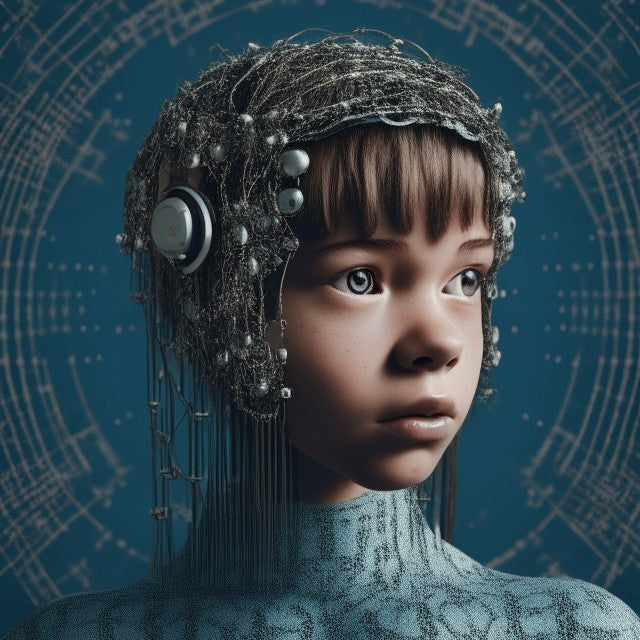What if technology could make "fitting in" obsolete?
Societal pressure to "fit in" has been a longstanding challenge for many, especially those on the autism spectrum. Autistic individuals often engage in "masking" to navigate social situations, a practice that can be mentally and emotionally draining. But what if technology could change the narrative? What if, instead of individuals trying to fit into society, technology could reshape society to be more inclusive.
A History of Conformity
Throughout history, societal norms have been the invisible hand guiding individual behavior, dictating what is deemed acceptable and what is not. These norms, often unwritten and unspoken, have evolved over time, shaped by cultural, political, and technological influences. But one constant remains: the pressure to conform.
In ancient times, societal norms were often rooted in religious or philosophical beliefs. For example, in ancient Greece, the concept of "arete" or excellence was a guiding principle. This meant living up to one's potential, but it also meant adhering to societal expectations. In many ancient cultures, stepping outside these norms could result in exile or even death.
As humans evolved and society progressed, we saw the Renassance period which brought a shift towards individualism. Yet, even then, there were clear societal expectations especially for those in higher social classes. The Victorian era can also exemplify several cases of societal norms dictating behavior. It was during this era that women were put into a "cult of domesticity". This involved putting a strong emphasis on the role of women as the bearers of morality and purity. Their primary roles were seen as wives and mothers, and they were discouraged from pursuing education or careers outside their family home. This norm was so pervasive that women who sought work or education were often viewed with suspicion or disdain.

The Reality of Autistic Masking
Autistic masking is a process by which an autistic individual consciously or unconsciously emulates or mimics the behavior of others around them, suppressing their autistic traits or behaviors in an effort to blend in or appear "normal" in neurotypical settings. This can involve mimicking facial expressions, forcing eye contact, suppressing stimming behaviors, or feigning interest in social nteractions. Essentially, it's a survival strategy many autistic people adopt to navigate a world that's largely designed for the neurotypcial majority.
The effect of masking on a person's well being overtime can be devastating.
Loss of Identity: Constantly suppressing one's natual behaviors and feelings can lead to a sense of lost identity. Over time, some may struggle to discern which parts of their personality and behavior are genuinely them and which parts are a result of the mask
Mental Exhaustion: Masking is mentally taxing. It requires a continuous, conscious effort to monitor and adjust one's behavior, speech, and reactions. This can be incredibly draining and lead to burnout and physical fatigue.Stress: The fear of slipping or being "found out" can heighten anxiety. There's a constant pressure to perform and maintain the mask, leading to heightened stress levels
Delayed Diagnosis: For those who mask their symptoms effectively, it can lead to delays in receiving an autism diagnosis. This means they might not get the support and understanding the need until much later in life.
Loneliness and Isolation: Even when surrounded by people, the act of masking can create a barrier. The individual might feel they are hiding their true self, leading to feelings of isolation even in social settings.
Cognitive Dissonance: This arises from a mismatch between one's internal experiences and external expressions. Over time, this dissonance can be distressing and confusing. Depression can set in as the individual begins to feel trapped in their mask and unable to express their true self.
How technology can make an impact
For years, technology has been a beacon of hope for many on the autism spectrum. Visual Communications boards, for example, have been instrumental in providing a voice to those who might otherwise struggle to express themselves. Apps designed specifically for autistic individuals have offered structured ways to understand and navigate social situations. Yet, while these tools have been groudbreaking, they've often been seen as "crutches" or necessary aids that highlight difference rather than fostering genuine understanding and integration.
A New Paradigm
What if the true potential of augmented reality and virtual reality lies not in gaming and entertainment but in reshaping our views and understanding neurodiversity?
Both augmented reality and virtual reality offer a unique lens through which we can view and interact with the world. They have the power to overlay digital information onto our physical environment or immerse us entirely in a new digital realm. This capability isn't just about enhancing our entertainment experiences; it's about fundamentally alerting how we perceive and engage with our surroundings.

The VR Portal
Imagine a VR world where users find themselves in a bustling party or a crowded classroom. To the neurotypical individual, this might seem like a regular scenario. However, through the lens of an autistic individual, the experience is transformed. Background chatter becomes an overwhelming cacophony, bright lights flash more intensely, and the subtle nuances of facial expressions become a complex puzzle. Users would need to navigate conversations, deciphering emotions and reactions without the innate social cues they're accustomed to. This simulation would provide a firsthand experience of the challenges many autistic individuals face in social settings, making abstract concepts palpably real. This would offer a glimpse into the heightened sensory perception often associated with autism, allowing users to truly feel the overwhelming influx of stimuli that some autistic individuals contend with daily.
From Sympathy to Empathy
Technology has the ability to take your average neurotypical person from a state of sympathy to one of empathy. This is a profound thing that alone can reshape lives.
| Sympathy | Empathy |
| Feeling compassion for someone | Feeling WITH someone |
| External Understanding | Internal Understanding |
| Pity or Concern | Shared emotions |
| Requires no shared experience | Often arises from a shared experience |

Upon removing the VR headset or AR glasses, users would carry with them an emotional memory, a visceral understanding that's far more impactful than any documentary or lecture. They would have felt the anxiety, the confusion, and the sensory overwhelm. But they would also experience moments of joy, like the beauty in patterns, the comfort of routines, and the profound depth of focus that autism can bring. This balanced portrayal can foster a holistic understanding, emphasizing both the challenges and the unique strengths of autistic individuals.
I challenge readers to see beyond the entertainment of VR and AR devices. Lets recognize their transformative power and advocate for the responsible and innovative use of these tools in promoting neurodiversity and understanding.




Leave a comment
This site is protected by hCaptcha and the hCaptcha Privacy Policy and Terms of Service apply.